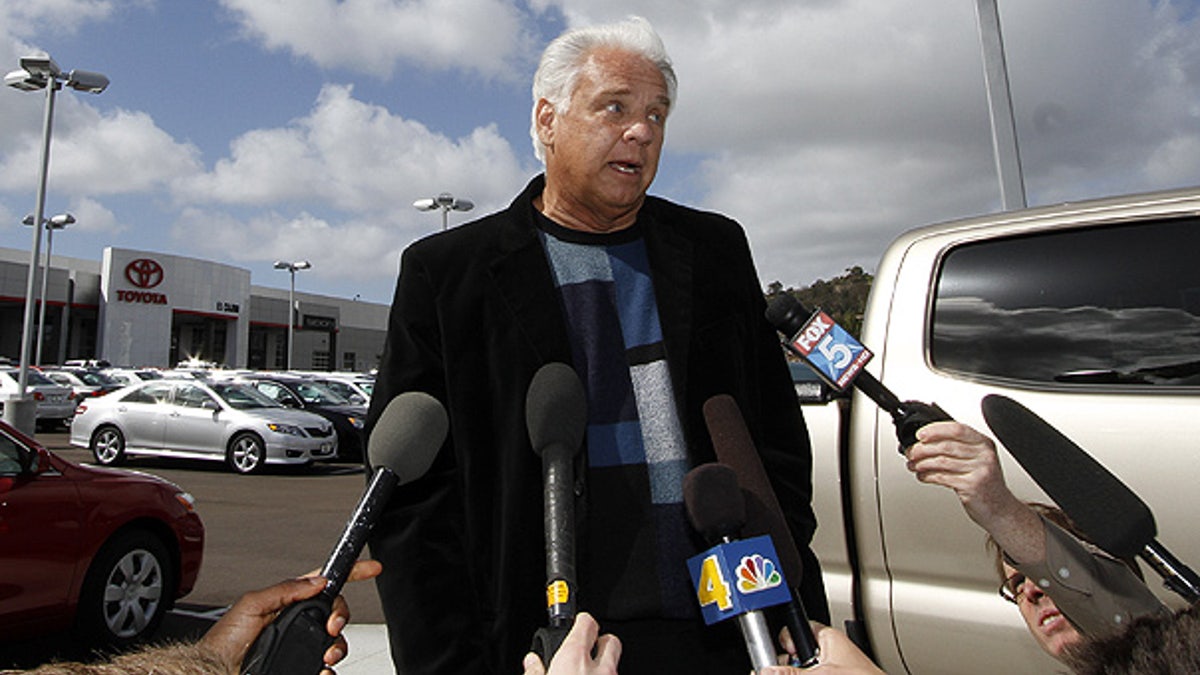
Mar. 9: Driver James Sikes talks about his experiences in his Toyota Prius during a news conference held at Toyota of El Cajon, Calif. (AP)
A federal safety investigation of the Toyota Prius that was involved in a dramatic incident on a California highway last week found a particular pattern of wear on the car's brakes that raises questions about the driver's version of the event, three people familiar with the investigation told the Wall Street Journal.
On Monday James Sikes, 61 years old, called 911 and told the operator his blue 2008 Toyota Prius had sped up to more than 90 miles per hour on its own on Interstate 8 near San Diego. He eventually brought the vehicle to a stop after a California Highway patrolman pulled alongside Sikes and offered help.
During and after the incident, Sikes said he was using heavy pressure on his brake pedal at high speeds.
But the investigation of the vehicle, carried out jointly by safety officials from the National Highway Traffic Safety Administration and Toyota engineers, didn't find signs the brakes had been applied at full force at high speeds over a sustained period of time, the three people familiar with the investigation said.
The brakes were discolored and showed wear, but the pattern of friction suggested the driver had intermittently applied moderate pressure on the brakes, these people said, adding the investigation didn't find indicators of the heavy pressure described by Sikes.
Toyota Corp. spokesman Mike Michels declined to confirm the Journal's report.
A draft memorandum obtained Saturday by The Associated Press also said investigators were unable to make a Prius speed out of control as Sikes detailed.
During two hours of test drives of Sikes' car Thursday, technicians failed to duplicate the same experience that Sikes described, according to the memo prepared for the House Committee on Oversight and Government Reform.
"Every time the technician placed the gas pedal to the floor and the brake pedal to the floor the engine shut off and the car immediately started to slow down," the memo said.
The report says that, according to Toyota's "residential Hybrid expert," the Prius is designed to shut down if the brakes are applied while the gas pedal is pressed to the floor. If it doesn't, the engine would "completely seize."
"In this case, knowing that we are able to push the car around the shop, it does not appear to be feasibly possible, both electronically and mechanically that his gas pedal was stuck to the floor and he was slamming on the brake at the same time," the memo said.
The findings raise questions about "the credibility of Mr. Sikes' reporting of events," said Kurt Bardella, a spokesman for California Rep. Darrell Issa, the top Republican on the committee, which is looking into the incident.
The memo did say that investigators found the front brake pads were spent.
"Visually checking the brake pads and rotor it was clearly visible that there was nothing left," it said.
Sikes' wife, Patty, said he stands by his story.
"Everyone can just leave us alone," she said. "Jim didn't get hurt. There's no intent at all to sue Toyota. If any good can come out of this, maybe they can find out what happened so other people don't get killed."
Patty Sikes said the couple's lives have been turned upside down since Monday and they are getting death threats.
"We're just fed up with all of it," she said. "Our careers are ruined and life is just not good anymore."
The memo describes a series of tests conducted by the company and NHTSA on Wednesday and Thursday. A full diagnostics was conducted, followed an inspection of the brakes and a test drive. The Prius was compared with a separate test vehicle provided by the San Diego dealership with identical year, make, model and color features as the one under investigation.
Following the tests, NHTSA bought the gas pedal, throttle body and the two computers from Sikes' vehicle, the memo said. The estimated cost was $2,500 for the parts and labor.
Jill Zuckman, spokeswoman for the U.S. Transportation Department that oversees the highway safety agency, said investigators "are still reviewing data and have not reached any conclusions."
The Wall Street Journal and the Associated Press contributed to this report.